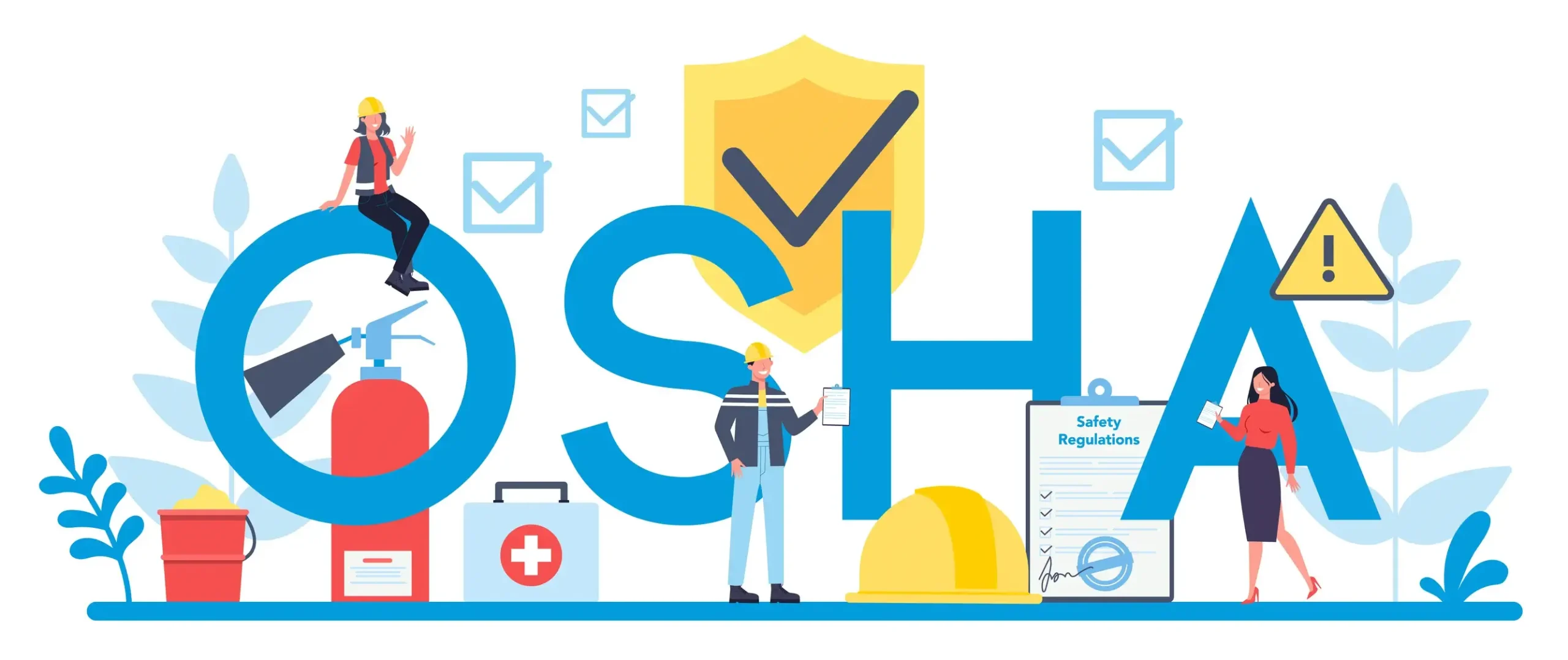This is a comprehensive guide to give clear information about the OSHA. In this article, you will learn what is OSHA, its mission, and its key responsibilities, from its evolution to real-life impact, this article covers everything. So, without further ado, let’s delve into this read!
OSHA Definition
The OSHA stands for Occupational Safety and Health Administration (OSHA), and is a federal agency in the United States. Being a pivotal governmental agency, it is responsible for safeguarding the well-being of workers in a variety of industries. Its main aim is to ensure the safety and healthful conditions for workers. The OHSA plays a critical role in minimizing workplace hazards, preventing accidents, and ensuring the overall welfare of employees.
OSHA’s Mission
“OSHA’s mission is to assure safe and healthful working conditions for working men and women by setting and enforcing standards and by providing training, outreach, education, and assistance. This mission statement underscores OSHA’s commitment to preserving and improving the well-being of the American workforce.
What Does The OSHA Do?
Many of you are still wondering about what OSHA means and what the OSHA does, so in simple words, it is an agency that operates by the government of a state whose primary mission is to Protect Workers Nationwide.
 The majority of individuals do not know the concept of Occupational Safety and Health. However, it has a long and evolving history. The Industrial Revolution of the 18th and 19th centuries played a significant role in bringing changes in the workplace and introducing risks and new dangers for workers. As industrialization expanded, so did the need for workplace regulations to protect employees the essential need for everyone.
The majority of individuals do not know the concept of Occupational Safety and Health. However, it has a long and evolving history. The Industrial Revolution of the 18th and 19th centuries played a significant role in bringing changes in the workplace and introducing risks and new dangers for workers. As industrialization expanded, so did the need for workplace regulations to protect employees the essential need for everyone.
The modern OHSA, as it exists in many countries today, is a product of extensive legislative and regulatory developments in the 20th century. In the United States, for instance, the Occupational Safety and Health Act was passed in 1970, establishing OSHA as a federal agency with the authority to set and enforce workplace safety and health standards. Similarly, other countries have their own OHSA equivalents, with varying degrees of authority and scope.
6 Key Responsibilities of OSHA to Know
The acronym of OSHA stands for the Occupational Safety and Health Administration. The OSHA’s purpose is to protect employees from workplace hazards and to reduce the risk of occupational injuries, illnesses, and fatalities. OSHA achieves this purpose through several key functions:
1. OSHA Sets Workplace Safety Standards
One of OSHA’s primary approaches to ensuring workplace safety and health is through the establishment and enforcement of regulations and standards. OSHA sets industry-specific standards that employers must adhere to. These standards cover a wide range of workplace hazards, including but not limited to:
- Hazard Communication: Ensuring that employees are aware of the dangers associated with chemicals used in the workplace and have access to appropriate safety data sheets.
- Fall Protection: Implementing measures to prevent falls, particularly in the construction industry where falls are a leading cause of fatalities.
- Hazardous Materials Handling: Establishing guidelines for the safe handling, storage, and disposal of hazardous materials.
- Machine Guarding: Requiring protective measures to prevent injuries from machinery and equipment.
- Respiratory Protection: Mandating the use of appropriate respiratory protection in environments with harmful airborne contaminants.
- Personal Protective Equipment (PPE): Ensuring the provision and proper use of PPE such as helmets, gloves, and eyewear.
These standards serve as a crucial foundation for maintaining safe working conditions. Employers are obligated to follow them, and OSHA conducts inspections to verify compliance.
2. OSHA Perform Inspections
OSHA employs a proactive approach to enforcement. The agency conducts inspections of workplaces to ensure that employers are complying with safety and health regulations. These inspections may be triggered by various factors, including:
- Complaints: OSHA takes complaints from workers or their representatives seriously and may conduct inspections based on these reports.
- Accidents and Fatalities: When a workplace accident results in a fatality or serious injury, OSHA investigates the incident to determine if any safety violations were involved.
- Programmed Inspections: OSHA has specific inspection programs targeting industries or workplaces with higher risks. These programmed inspections are conducted periodically to assess compliance.
- Follow-Up Inspections: If violations are found during an initial inspection, follow-up inspections may be scheduled to ensure that corrective actions have been taken.
During inspections, OSHA compliance officers examine the workplace, review safety records, and interview workers. If violations are discovered, OSHA can issue citations, along with fines or penalties, to encourage prompt correction. The enforcement of these regulations serves as a strong deterrent to unsafe practices.
3. Authorize OSHA Safety Training
OSHA recognizes that prevention is just as important as enforcement. To this end, the agency authorizes extensive educational resources and training programs. Instituions associated with OSHA offers various training courses, often in collaboration with industry associations and labor unions. These courses cover a wide array of topics and are designed for both employers and employees. They include, but are not limited to:
- OSHA 10-Hour and 30-Hour Courses: Courses such as OSHA 10-hour construction and OSHA 30-hour construction courses provide an overview of key safety topics and are suitable for both workers and supervisors.
- Hazard Recognition and Prevention: These courses help workers identify workplace hazards and learn how to mitigate them.
- Emergency Preparedness: Training to prepare employees and employers for emergency situations such as fires, natural disasters, and chemical spills.
Furthermore, OSHA has a specific focus on outreach and education. The agency hosts campaigns and initiatives that aim to raise awareness about specific hazards or industries. For example, OSHA’s “Safe + Sound Week” encourages employers to engage in safety and health programs, promoting a culture of safety in the workplace.
4. OSHA Outreach & Assistance
OSHA offers various outreach and assistance programs. The agency provides consultation services, often free of charge, to help employers identify and correct safety and health hazards in their workplaces. OSHA’s On-Site Consultation Program is designed for small and medium-sized businesses that may lack the resources or expertise to effectively address safety concerns. The program offers recommendations for improvement while maintaining the confidentiality of the employer.
OSHA also maintains alliances with industry associations, labor unions, and other organizations to promote safety and health awareness. These alliances foster cooperation and facilitate the sharing of best practices and knowledge to enhance workplace safety.
5. Promotes Voluntary Programs
OSHA understands that no single entity can address all workplace safety issues alone. The agency collaborates with a wide range of partners, including state and local government agencies, to collectively address safety concerns. In many cases, state governments have their own OSHA-approved state plans that implement and enforce workplace safety standards.
OSHA’s partnerships extend beyond the government sector. The agency works with employers, labor organizations, industry associations, and advocacy groups to create a safety-conscious culture. Through cooperative programs, OSHA encourages organizations to develop and implement safety and health management systems.
6. Offer Whistleblower Protection
To encourage employees to report safety concerns without fear of retaliation, OSHA administers a robust whistleblower protection program. Workers have the right to report safety violations, unsafe working conditions, and other concerns without being subject to adverse employment actions.
In addition, OSHA investigates these complaints and takes action when violations of whistleblower protection laws are discovered. This approach helps ensure that individuals are not discouraged from raising safety concerns. OSHA’s definition is to consider employees’ safety first, which is why they make efforts to secure employees from any kind of risky situation.
Conclusion
The Occupational Health and Safety Authority, or its equivalent in different countries, serves as a cornerstone in ensuring that workplaces are safe and healthy environments for employees. Over the years, these agencies have made substantial progress in reducing workplace accidents, promoting safety awareness, and enhancing overall worker welfare. By continually adapting to evolving workplace risks and maintaining a commitment to safeguarding workers, OHSA and similar organizations play a critical role in fostering safer and healthier workplaces.



